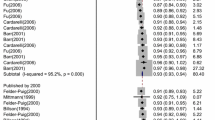Abstract
The need to harmonize different outcome metrics is a common problem in research synthesis and economic evaluation of health interventions and technology. The purpose of this paper is to describe the use of multidimensional item response theory (IRT) to equate different scales which purport to measure the same construct at the item level. We provide an overview of multidimensional IRT in general and the bi-factor model which is particularly relevant for applications in this area. We show how both the underlying true scores of two or more scales that are intended to measure the same latent variable can be equated and how the item responses from one scale can be used to predict the item responses for a scale that was not administered but are necessary for the purpose of economic evaluations. As an example, we show that a multidimensional IRT model predicts well both the EQ-5D descriptive system and the EQ-5D preference index from SF-12 data which cannot be directly used to perform an economic evaluation. Results based on multidimensional IRT performed well compared to traditional regression methods in this area. A general framework for harmonization of research instruments based on multidimensional IRT is described.


Similar content being viewed by others
References
Agency for Healthcare Research and Quality: Calculating the U.S. Population-based EQ-5D™ Index Score. http://www.ahrq.gov/professionals/clinicians-providers/resources/rice/EQ5Dscore.html (2005). Accessed 1 June 2013
Bock, R.D., Aitkin, M.: Marginal maximum likelihood estimation of item parameters: application of an EM algorithm. Psychometrika 46, 443–459 (1981)
Bock, R.D., Gibbons, R.D.: Factor analysis of categorical item responses. In: Nering, M., Ostini, R. (eds.) Handbook of Polytomous Item Response Theory Models: Development and Applications. Lawrence Erlbaum, Florence (2010)
Brooks, R., Rabin, R., Charro, F.D.: The Measurement and Valuation of Health Status Using EQ-5D: A European Perspective: Evidence from the EuroQol BIO MED Research Programme. Springer, New York (2003)
Chuang, L.-H., Kind, P.: Converting the SF-12 into the EQ-5D. Pharmacoeconomics 27(6), 491–505 (2009). doi:10.2165/00019053-200927060-00005
Duan, N., Manning, W.G., Morris, C.N., Newhouse, J.P.: A comparison of alternative models for the demand for medical care. J. Bus. Econ. Stat. 1(2), 115–126 (1983). doi:10.2307/1391852
Fleishman, J.A.: Demographic and Clinical Variations in Health Status. http://meps.ahrq.gov/data_files/publications/mr15/mr15.pdf (2005). Accessed 1 Nov 2013
Franks, P., Lubetkin, E.I., Gold, M.R., Tancredi, D.J., Jia, H.: Mapping the SF-12 to the EuroQol EQ-5D Index in a national US sample. Med. Decis. Mak. 24(3), 247–254 (2004)
Gibbons, R.D., Hedeker, D.: Full-information item bifactor analysis. Psychometrika 57, 423–436 (1992)
Gibbons, R.D., Bock, R.D., Hedeker, D., Weiss, D., Bhaumik, D.K., Kupfer, D., Frank, E., Grochocinski, V., Stover, A.: Full-information item bifactor analysis of graded response data. Appl. Psychol. Meas. 31, 4–19 (2007)
Gray, A.M., Rivero-Arias, O., Clarke, P.M.: Estimating the association between SF-12 responses and EQ-5D utility values by response mapping. Med. Decis. Mak. 26(1), 18–29 (2006). doi:10.1177/0272989X05284108
Hedeker, D., Gibbons, R.D.: Longitudinal Data Analysis. Wiley, New York (2006)
Holzinger, K.J., Swineford, F.: The bifactor method. Psychometrika 2, 41–54 (1937)
Joreskog, K.G.: A general approach to confirmatory maximum likelihood factor analysis. Psychometrika 34, 183–202 (1969)
Lawrence, W.F., Fleishman, J.A.: Predicting EuroQoL EQ-5D preference scores from the SF-12 Health Survey in a nationally representative sample. Med. Decis. Mak. 24(2), 160–169 (2004). doi:10.1177/0272989X04264015
Le, Q.A., Doctor, J.N.: Probabilistic mapping of descriptive health status responses onto health state utilities using Bayesian networks: an empirical analysis converting SF-12 into EQ-5D utility index in a national US sample. Med. Care 49(5), 451–460 (2011). doi:10.1097/MLR.0b013e318207e9a8
Li, L., Fu, A.Z.: Some methodological issues with the analysis of preference-based EQ-5D index score. Health Serv. Outcomes Res. Methods 9(3), 162–176 (2009). doi:10.1007/s10742-009-0053-3
Longworth, L., Rowen, D.: Mapping to obtain EQ-5D utility values for use in NICE health technology assessments. Value Health 16(1), 202–210 (2013). doi:10.1016/j.jval.2012.10.010
Muthen, B.O.: Latent variable modeling in heterogeneous populations. Psychometrika 54, 557–585 (1989)
Rubin, D.B.: Inference and missing data. Biometrika 63, 581–592 (1976)
Samejima, F.: Estimation of latent ability using a response pattern of graded scores. Psychom. Monogr. Suppl. 35, 139–139 (1969)
Shaw, J.W., Johnson, J.A., Coons, S.J.: US valuation of the EQ-5D health states: development and testing of the D1 valuation model. Med. Care 43(3), 203–220 (2005)
Sullivan, P.W., Ghushchyan, V.: Mapping the EQ-5D index from the SF-12: US general population preferences in a nationally representative sample. Med. Decis. Mak. 26(4), 401–409 (2006). doi:10.1177/0272989X06290496
Torrance, G.W., Thomas, W.H., Sackett, D.L.: A utility maximization model for evaluation of health care programs. Health Serv. Res. 7(2), 118–133 (1972)
Tucker, L.R.: An inter-battery method of factor analysis. Psychometrika 23, 111–136 (1958)
Ware Jr, J., Kosinski, M., Keller, S.D.: A 12-Item Short-Form Health Survey: construction of scales and preliminary tests of reliability and validity. Med. Care 34(3), 220–233 (1996)
Acknowledgments
This work was supported by NIMH grant MH66302 (RDG) and AHRQ Grants 1U18HS016973 (RDG) and T32HS000084 (MCP).
Author information
Authors and Affiliations
Corresponding author
Rights and permissions
About this article
Cite this article
Gibbons, R.D., Perraillon, M.C. & Kim, J.B. Item response theory approaches to harmonization and research synthesis. Health Serv Outcomes Res Method 14, 213–231 (2014). https://doi.org/10.1007/s10742-014-0125-x
Received:
Revised:
Accepted:
Published:
Issue Date:
DOI: https://doi.org/10.1007/s10742-014-0125-x




